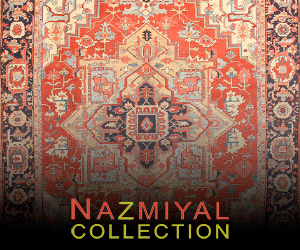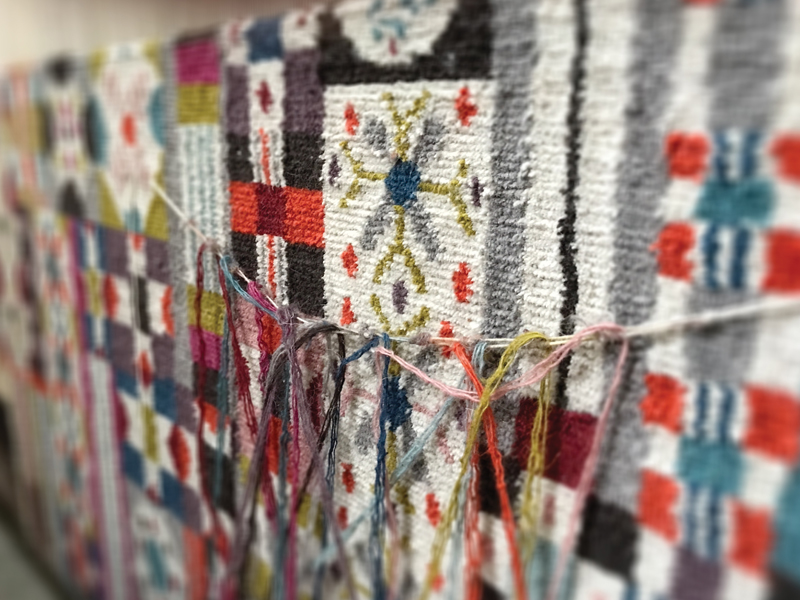Laurie Downing is no stranger to the world of rugs and carpets. So while her new firm Wool Song brings refreshing, colorful, and stylish hand-knotted carpets to the market, it does so with the knowledge and history of the craft and the industry. On first look, it’s a formula for success.
While touring production facilities in Kathmandu, Nepal in December 2018, amongst others in view a particularly charming striped rug caught my eye, begging for attention. “This is beautiful craftsmanship of course,” I recall saying to the owner of the manufactory who was graciously giving me a tour, “but the design and color are really fantastic. Simple and naive but very nicely done and well matched to the texture I might add,” I stated with definitive confidence before sheepishly asking, “Whose work is this if I may ask?”
That is how I came to know of Laurie Downing and her new firm Wool Song. It’s also an apt introduction to a personality long familiar with the world of hand-knotted rugs and carpets, yet unknown to me and perhaps to many of you, thus highlighting both the close knit nature of the industry as well as its secretive and often anachronistic nature. But to get to know and understand Downing would take furtive messaging in hopes of sharing the beautiful work I had seen (I had to wait until now) followed by thoughtful discussion with her regarding the launch of Wool Song and her intentions for the future.
“It’s so nice to go away and [then] to come back as everything is fresh and new,” said Downing as we discussed her career thus far. She said this in reference to her decade away from the rug and carpet industry during which time she focused on fine art publishing, yet the allure of hand-knotted rugs was strong if not also nostalgic and in need of a revisit. “My co-ownership of a fine art publishing company for sixteen years was instrumental in renewing my interest in working again with artists in this different medium. Wool Song is a combination of two long-term career tracks,” states Downing.
She began her career in rugs when Tibet Rug Company hired her as a graphic designer to create print and marketing collateral. Early on in the course of her fifteen-plus years with the pioneering firm, she designed some of the very first carpets, several of which garnered accolades for Tibet Rug Company as winners of an America’s Magnificent Carpets® Award during
the National Oriental Rug Show at AmericasMart in Atlanta, Georgia. But creatives being creatives, myself included, Downing was attracted to other opportunities and left rugs for that aforementioned break.
“I’ve always been drawn to visual beauty of any form. Anything visual, be it something in a museum or a commercial product, inspires. And I just love working," states Downing who then further explains Wool Song is not simply about the collection of her own designs. It's about showcasing the technical possibilities and then creating made-to-order and commissioned work, drawing on Wool Song as a resource to spark the imagination of the customer so that they “Love it!” as Downing told me. Moreover, via the addition of Wools Song’s soon-to-be introduced “Artists Series,” Downing is adding the work of others into the firm’s repertoire to tell artful stories while supporting companies and artists who create beautiful work.
Wool Song is not a vanity project for Downing. Rather, it is a rug company in the same indicative way notable firms of the 1990s operated—with a deft understanding of design, technique, materials, and construction, matched with a Nepali maker of Tibetan carpets who not only honors the craft of carpetry but also is willing to try new approaches. As if to summarize her ethos and mantra, Downing said, “When the work becomes solely about money or ‘design by committee’… Well, why would I want to make something that has been done, when I can bring something new?”
This is not to say Wool Song isn’t a motivated commercial concern, it’s to say that in this era when handmade, particularly hand-knotted, is under ever increasing financial and logistical pressures, perhaps it is wise to revisit the form and consider new opportunities. “I want to preserve the craft of Tibetan carpet making and support the Nepali carpet industry. I feel Wool Song does this via our unique designs, and our exploration of texture,” says Downing while hinting at the current trend toward texture and handmade everything amongst emerging consumer demographics.
“My motivation is sharing my work and exploring new possibilities. I enjoy creative adventures,” adds Downing before concluding with words which resonate deeply within my soul. “One of my personal directives is to share rug knowledge and appreciation with young buyers in order to help to renew interest in the product.” Hear her, hear her.
woolsong.com
Image courtesy of Michael Christie





